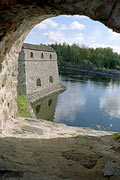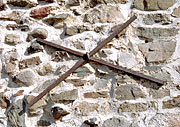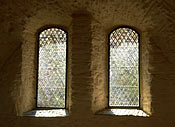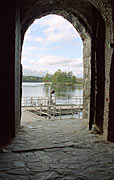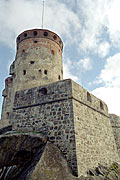Savonlinna Fortress
After the conclusion of Orekhov's peace in 1323 the present territory of Finland was divided between the Novgorod Republic and Sweden Kingdom. However, as it were, the border demarcation has not been undertaken carefully along all the border, so to speak, so many clashes and disturbances begun along the borderline. After all in 1475 the governor of Vyborg Eric Axelson Tott decided to found a frontier fortress on the tiny rocky island in the channel Kuronsalmi, between the lakes of Hankivesi and Pihlajavesi, in the northern part of Saima Lake.
Novgorod considering this place as its own lands (and indeed, according to the latest explorations borderline was at 5 km. north) tried to prevent the construction of the fortress, and even sunk some barge with building materials. However, the place was excellent for the defense and in the summer and winter (the channel where fortress's island was did not freeze) and the Swedish fortress with the help of masons from Revel town was built.
The fortress had at that time three towers connected by walls from the main corps inside of it. Later two more Towers were built - Thick tower and the Kijlin tower were their names. The fortress was named Olavinlinna or Olafsborg or Fortress St.Olaf in honor of first Baptist in Scandinavia Olaf the King of Norway who lived in the 11 AD.
Olavinlinna fortress became the administrative center of Savo province. In 1495 and 1496 Olavinlinna was besieged by troops of Russian tzar Ivan III, but withstood. During the war with Russia of Sweden king Gustav Vasa's time (1555-1557) a fortress had the garrison of two hundred men and withstood several tough sieges.
Olavinlinna was the Swedish border fortress till the beginning of the Great Northern War in 1700. In 1714 the Russian army besieged the fortress and forced it to surrender after a long and brutal siege. There was a Russian garrison till the end of the war in 1721 when the fortress was given back to the Swedes. However, after the war with Russia 1741–1743 the fortress become the Russian border outpost.
In 1809, after all Finland annexation Olavinlinna fortress lost its military value, although there was a garrison till 1847. In 1850 the fortress was used as a prison.
There were two fires in the fortress in 1860 with considerable damage (there are strange parallels with the Vyborg castle). For some time Olavinlinna was abandoned and deserted. Restoration work began in the early twentieth century and main restoration work were made in 1961-1975, when the fortress was opened for public.
In 1912 the first opera festival was held in Savonlinna. These festivals were here until 1917 and then resumed in 1967 and continues till nowadays. The stage being constructed each spring in the main courtyard of the fortress and numerous theatrical companies and performances could be seen here as well as the Russians artists of Kirov Ballet from St.Petersburg or Bolshoi Theatre from Moscow. Tickets are sold on half year ahead and there are is not easy to find cheap accommodation in the area because of this festival.
Impressions
It is needed to say the Savonlinna was the first city abroad I have reach. It was at the beginning of the dark era of Perestroika, so the impression was a very bright at all.
There is an interesting mix of old towers and walls and a bastion of the new system.
The fortress is renovated neat and tidy, clean and carefully. The fortress used to: a. make money with the tourists, b. as a place for various festivals, celebrations and other conferences, c. for landscape decorating. If you compare it with our Russian fortresses condition, you'll understand.
No need for lantern, hiking clothing and boots and etc. what you'll need for exploration of ruins of Mannerheim Line in Karelia for example. But, there is an entrance fee. Also, you need to get a local guide, because there is no admittance to upper floors of the towers without guidance.
Land forts and fortress:
Bip Castle Gatchina Ivangorod Izborsk Kexholm Kirillov Monastery Koporye Novgorod Pechorskiy Monastery Peter&Paul Fortress Porkhov Pskov Schlisselburg Staraya Ladoga Tikhvin Vyborg Hameenlinna Hamina Kastelholm Kymenlinna Lappaenranta Raseborg Castle Savonlinna Tavetti Turku Visby Fredrikstadt Fredriksten Hegra Fort Hoytorp Fort Arensburg Narva Tallinn Antipatris Caesarea Jerusalem Latrun Fort Masada
Sea forts and fortresses:
Alexander Fort Ino Fort Krasnaya Gorka Fort Kronstadt: Kotlin isl. Kronstadt: North Forts Kronstadt: South Forts Trongsund Hanko Svartholm Sveaborg Marstrand Siaro Fort Vaxholm Oscarsborg
Artillery batteries and individual guns:
Coastal Artillery Hemso Fort
Fortified areas and defensive lines:
Karelian Fortified Area (KaUR) KrUR Leningrad Mannerheim Line Nevsky Bridgehead VT Line Harparskog Line Salpa Line Gothland
Russian
S e a r c h All news


